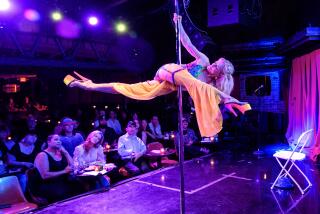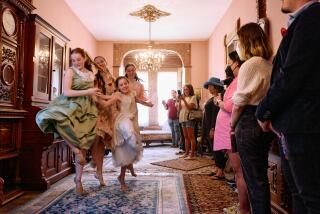Dancers Have a Ball Practicing for Contests
- Share via
George Bush and Dan Quayle were as shy as adolescents on the dance floors at their inaugural balls last Friday, pleading two left feet and a bum sense of rhythm while the whole world was watching.
That same night, Hal Bramsen of Sherman Oaks, 77, showcased his waltzing in front of an enthusiastic crowd of about 50 fellow students at the Arthur Murray Dance Studio in downtown Van Nuys. So did Helen Pugh, a veteran tango and quick-step performer who happens to be 80 years old; Bonnie Biddle, a first-timer rehearsing a rumba, and 19 others.
They were preparing routines for a Southern California Arthur Murray amateur competition Feb. 19 at the Los Angeles Hilton Hotel. After this, winners may continue in ascending levels of competition until they reach national dance-offs.
There to give them tips Friday was professional dancer David Kloss, 35, also of Sherman Oaks. He and his wife hold the current Arthur Murray and American national ballroom dancing titles and tour the nation giving lessons and judging competitions.
But there’s more to competitive ballroom dancing than trophies and ribbons. For some, it’s exercise less onerous than pumping iron. For others, it provides companionship, confidence or an outlet for a sensibility missing in their working lives.
Consider Dale Clemons, a 50-year-old bachelor who supervises a North Hollywood machine shop. On the dance floor, Clemons has won “60 or 70” trophies and at least 200 ribbons, he said, competing all over the country in the waltz and four other dance styles.
“Everyone in the plant knows I dance and do these events,” Clemons said. “But you want to talk about two different life styles!”
Clemons spends as much as $500 a month on lessons, at $67 for 40 minutes of private instruction. But it’s worth it to him. “I can’t find anything better to spend my money on,” he said, adding that he’d grown tired of the bar and disco social scene.
The scene at Arthur Murray’s on Friday was less disco and more small-town Veterans of Foreign Wars dance. A majority of the students were middle-aged or older, couples and singles, wearing the latest in 1960s fashions, although a few were hip young Latinos in their early 20s sporting string ties and pompadours.
Students sat at plastic-covered folding tables and drank punch and mixed drinks out of plastic foam cups. The sound system was turned up too high, and it distorted the Henry Mancini and Nat King Cole and salsa-flavored tango music. The lights seemed too bright, and trays of sandwiches, black olives and pickles appeared slightly wilted. During the breaks in competition, everyone danced with anyone who asked.
But on the dance floor, glamour returned, and eyes sparkled. The waltz performed by Janet Bramsen, 70, with hard-working instructor Jesse de la Cruz drew some of the warmest applause of the evening. Wearing a sky-blue ball gown decorated with sequins, gold clasps and other hardware, she confidently lay back on Cruz’s tuxedoed arm and gracefully twirled to the “Theme from Romeo and Juliet.”
‘Just for Fun’
“The people here are as supportive as they are in many churches,” she said. “Everyone is happy for everyone else if they do well. We all realize we’re in this just for fun, so we don’t take it too seriously.”
When Hal Bramsen retired in 1980 from his job as business manager at Cal State Northridge, his wife said, they needed an activity they could do together. Her arthritis barred golf. And so, “I decided we would do this, and he was a very good sport.”
That may be how many husbands start dance lessons. But now, Hal said, he enjoys the competitions and the chance to show off when he and his wife go to discos.
“It’s fun if you can find enough room to make a few steps,” he said. “That’s really very satisfying.”
Saugus resident Cheryl Akerly, 40, decided to start lessons without her husband. “I got sick of sitting on the sidelines my whole life,” said Akerly, a fund-raiser for a Burbank hospital.
She has had only one lesson so far, but would like someday soon to begin competing. As she watched dancers of all ages and all levels of talent perform, Akerly said: “This is not just dancing development, this is character development.”
Bonnie Biddle, 39, would agree. Biddle, who works for a Westlake Village insurance company, said getting up and doing a rumba with her teacher after a year of lessons was a way of “pushing myself one step further.”
During the past year, Biddle has enrolled in college classes and has been “losing a lot of weight,” she said. “There’s been a lot of changes in my life, and this is helping.”
The proprietor of the studio is Mario Vitucci, 50, an Italian immigrant who comes from a family of butchers. Vitucci, still trim in a skintight black tuxedo, has been teaching dance since 1961 and has operated the Van Nuys studio since 1963.
He has seen the town change. Pawn shops and a 99-cent store are now on the block, which was once one of the Valley’s prime shopping areas. Limp, deflated balloons and streamers hang from the sidewalk overhang of the indoor swap meet next door. The area now attracts immigrants from around the world.
But Vitucci’s largely Caucasian clientele has not changed as much. A few Asians and more than a few Latinos take lessons now, and most of the students, Vitucci said, come from the Valley.
Lindy and Mambo
And they still want to learn the swing--also known as the Lindy or the jitterbug--the waltz, the tango and other classics. Last year’s big hit, of course, was the Latin mambo, which most closely resembles the action in the movie “Dirty Dancing.”
January is the studio’s biggest month. People go out to dance on New Year’s Eve and enjoy it and want to learn to do it right. Or, he said, they want to exercise to take off holiday poundage, and they don’t want to go to a sweaty gym.
But once they start, many compete. Vitucci saw five students and three teachers go to Cleveland for the Ohio Star ball last fall, one of the largest regional dance competitions in the country, and they won 31 first, second and third prizes.
The professional division of that competition will be televised on Channel 28 Saturday at 9 p.m. Kloss and his wife, Carrie, will be seen defending their American title.
Kloss, who has watery blue eyes, perfectly coiffed blond hair and whiter-than-white teeth, said there is a big difference between that level of competition and the dancers he critiqued last week.
For them, dancing is a hobby. For him, it’s his job, and he takes the glitter, the costumes and, in a certain circle, the fame all in stride.
But, he acknowledged, perhaps in their own minds all the dancers see themselves in a bright spotlight, handsome and beautiful, forever on the beat, forever young.


